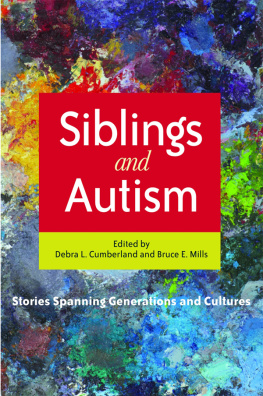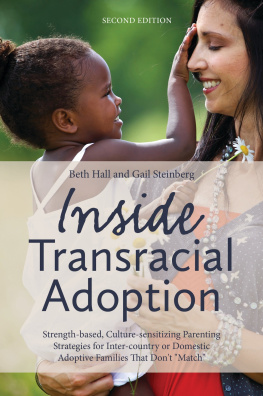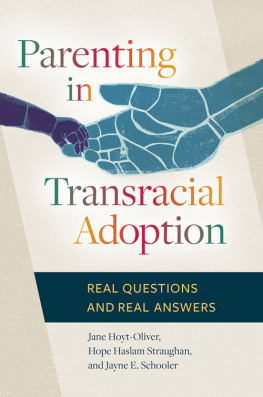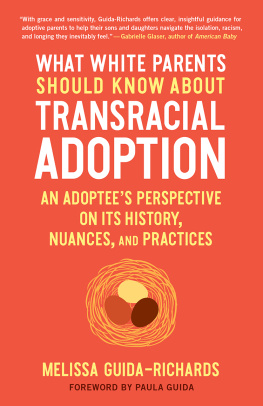Columbia University Press
Publishers Since 1893
New York Chichester, West Sussex
cup.columbia.edu
Copyright 2009 Columbia University Press
All rights reserved
E-ISBN: 978-0-231-51994-6
Library of Congress Cataloging-in-Publication Data
Simon, Rita James.
In their siblings voices : white non-adopted siblings talk about their experiences being raised with black and biracial brothers and sisters / Rita J. Simon and Rhonda M. Roorda
p. cm.
Includes bibliographical references.
ISBN 978-0-231-14850-4 (cloth : alk. paper) ISBN 978-0-231-14851-1 (pbk. : alk. paper) ISBN 978-0-231-51994-6 (e-book)
1. Interracial adoptionUnited States 2. Child developmentCross-cultural studies. 3. Ethnicity in childrenUnited States. 1. Roorda, Rhonda M., 1969II. Title.
HV875.64.S5578 2009
306.87508900973dc22
2008045103
A Columbia University Press E-book.
CUP would be pleased to hear about your reading experience with this e-book at .
References to Internet Web sites (URLs) were accurate at the time of writing. Neither the author nor Columbia University Press is responsible for URLs that may have expired or changed since the manuscript was prepared.
This book, the third in the series on transracial adoption, follows the publication of In Their Own Voices: Transracial Adoptees Tell Their Stories (2000) and In Their Parents Voices: Reflections on Raising Transracial Adoptees (2007). The first two books in the series continue to be extremely well received, especially among adoptees and adoptive parents; researchers; students; adoption agencies and support groups; the media; and those interested in social work, adoption, and race relations in the United States. One of the greatest joys I have gained from the publication of these volumes is that teenagers, adult adoptees of color, and adoptive parents living in the United States and in other countries have been able to identify with those interviewed in those first two books. Since the books were published, numerous students completing their masters theses or doctoral dissertations on transracial adoption have expressed that the two books, particularly In Their Own Voices, were useful resources in their research. It was also gratifying to learn that the students own curiosity about transracial adoption was piqued by reading these books. In Their Own Voices and In Their Parents Voices are included in social work, English, and ethnic studies curricula in higher education and in adoption and cultural competency training courses. Both volumes remain relevant to families, scholars, and practitioners in todays society.
This current volume, In Their SiblingsVoices: White Non-Adopted Siblings Talk about Their Experiences Being Raised with Black and Biracial Brothers and Sisters, examines the experiences of the white non-adopted siblings living in the original families that appeared in the first two volumes and elicits their views on transracial adoption. This third volume should add substantially to the adoption literature and further open the doors of understanding and dialogue about this vital subject.
For the first volume we interviewed black and biracial adopted men and women who were raised in white homes beginning in the late 1960s and early to mid-1970s, and who had long been the subject of controversy over whether transracial adoption was viable for children and families over the long term. In the first phase of our research, we focused on locating black and biracial transracial adoptees essentially through word of mouth, placing an ad in a magazine on multicultural issues, and soliciting well-known personalities. Some individuals who learned about our project through friends, teachers, and colleagues contacted us personally because of their interest in participating in the project.
Our objective in the first volume of the series was to explore how the transracial adoptees integrated themselves into their adoptive families, and how they developed their own self-identities and self-esteem in the process. We also wanted to know how they fit in with their peers throughout their child/adolescent and early adulthood years, and to understand the inner journey the participants took to reconcile who they were in relation to how their adoptive families and society perceived them. The questions posed to the participants in the first volume were therefore designed to address some of the most sensitive issues inherent in transracial adoptionrace, identity, adoption, family, and societyissues that remain at the heart of the discussion on transracial adoption.
In the second volume we interviewed the adoptive parents of the men and women who participated in volume 1, In Their Own Voices. Our goal was to learn how these parents viewed transracial adoption thirty years later, after they had raised their children to adulthood and were establishing relationships with them as black men and women. Would their experiences be similar to those cited in the traditional body of research? Equally intriguing was to hear their responses in view of the fact that many of these parents had read the powerful and intimate accounts by their sons and daughters and other black and biracial transracial adoptees featured in In Their Own Voices.
As students of transracial adoption, my co-author, Rita Simon, and I felt compelled to include volume 2 in the series centering on the adoptive parents in order to provide a platform to hear their voices collectively and in continuum with In Their Own Voices. At the same time our goal was to offer readers insight into this complex issue from the perspective of parents who made the life-changing decision to adopt transracially. In most cases the parents who participated had limited resources to assist them in their parenting; they had to rely on their own skills, modeled for them by their parents, and they depended on the support of family members and friends, some of whom were taking similar paths. For these parents, transracial adoption was uncharted territory and did not come with a compass to guide them. In the course of interviewing the parents for volume 2, our hope was to elucidate the barriers these families broke through and to reveal the work that remains to ensure that transracial adoption can be successful for every family member.
Without question, the lessons learned by the transracial adoptive parents who participated (and others like them) are directly relevant for parents who are planning to adopt transracially or have already chosen this option as a way to build their families. Yet, on a broader scale, particularly as this nation continues to grapple with finding permanent and stable homes for many thousands of children in our foster care system, the parents of








